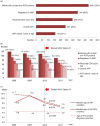Uptake of early infant diagnosis in Thailand's national program for preventing mother-to-child HIV transmission and linkage to care, 2008-2011
- PMID: 26968214
- PMCID: PMC4788772
- DOI: 10.7448/IAS.19.1.20511
Uptake of early infant diagnosis in Thailand's national program for preventing mother-to-child HIV transmission and linkage to care, 2008-2011
Abstract
Introduction: Early infant diagnosis (EID) has been a component of Thailand's prevention of mother-to-child HIV transmission (PMTCT) programme since 2007. This study assessed the uptake, EID coverage, proportion of HIV-exposed infants receiving a definitive HIV diagnosis, mother-to-child transmission (MTCT) rates and linkage to HIV care and treatment.
Methods: Infant polymerase chain reaction (PCR) testing data from the National AIDS Program database were analyzed. EID coverage was calculated as the percentage of number of HIV-exposed infants receiving ≥ 1 HIV PCR test divided by the number of HIV-exposed infants estimated from HIV prevalence and live-birth registry data. Definitive HIV diagnosis was defined as having two concordant PCR results. MTCT rates were calculated based on infants tested with PCR and applied as a best-case scenario, and a sensitivity analysis was used to adjust these rates in average and worst scenarios. We defined linkage to HIV care as infants with at least one PCR-positive test who were registered with Thailand's National AIDS Program. Chi-squared tests for linear trend were used to analyze changes in programme coverage.
Results: For 2008 to 2011, the average EID coverage rate increased from 54 to 76% (p < 0.001), with 65% coverage (13,761/21,099) overall. The number of hospitals submitting EID samples increased from 458 to 645, and the percentage of community hospitals submitting samples increased from 75 to 78% (p = 0.044). A definitive HIV diagnosis was made for 10,854 (79%) infants during this period. The adjusted MTCT rates had significantly decreasing trends in all scenarios. Overall, an estimated 53% (429/804) of HIV-infected infants were identified through the EID programme, and 80% (341/429) of infants testing positive were linked to care. The overall rate of antiretroviral treatment (ART) initiation within one year of age was 37% (157/429), with an increasing trend from 28 to 52% (p < 0.001).
Conclusions: EID coverage increased and MTCT rates decreased during 2008 to 2011; however, about half of HIV-infected infants still did not receive EID. Most HIV-infected infants were linked to care but less than half initiated ART within one year of age. Active follow-up of HIV-exposed infants to increase early detection of HIV infection and early initiation of ART should be more widely implemented.
Keywords: EID; HIV; Thailand; antiretroviral therapy; linkage to care; national PMTCT programme evaluation; prevention of mother-to-child HIV transmission.
Figures




References
-
- UNAIDS. AIDSinfo. 2015. [cited 2015 Sep 26]. Available from: http://aidsinfo.unaids.org/#.
-
- Newell ML, Coovadia H, Cortina-Borja M, Rollins N, Gaillard P, Dabis F. Mortality of infected and uninfected infants born to HIV-infected mothers in Africa: a pooled analysis. Lancet. 2004;364(9441):1236–43. - PubMed
-
- Policy Brief: consolidate guidelines on the use of antiretroviral drugs for treating and preventing HIV infection: what's new. World Health Organization; 2015. [cited 2015 Dec 15]. Available from: http://www.avac.org/sites/default/files/resource-files/guidelines_Nov201....
-
- Phanuphak P, Leechawengwong M, Siraprapasiri T, Juntratit W, Techasathit W, Teeraratkul A, et al., editors. National guidelines on HIV/AIDS diagnosis and treatment: Thailand 2010. Bangkok, Thailand: The agricultural co-operative federation of Thailand, Ltd; 2010.
-
- Ongwandee S, Lertpiriyasuwat C, Lolekha R, Sukkul A, editors. Thailand National Guidelines on HIV/AIDS Treatment and Prevention. Bangkok, Thailand: Department of Disease Control, Ministry of Public Health, Department of Disease Control, Ministry of Public Health. The agricultural co-operative federation of Thailand, Ltd; 2014.
Publication types
MeSH terms
Grants and funding
LinkOut - more resources
Full Text Sources
Other Literature Sources
Medical

